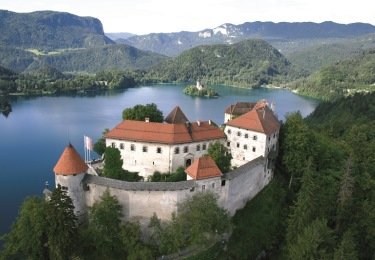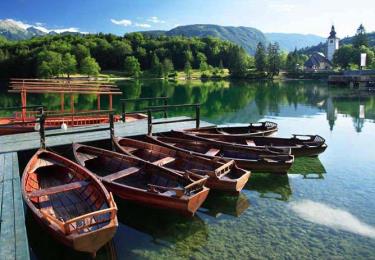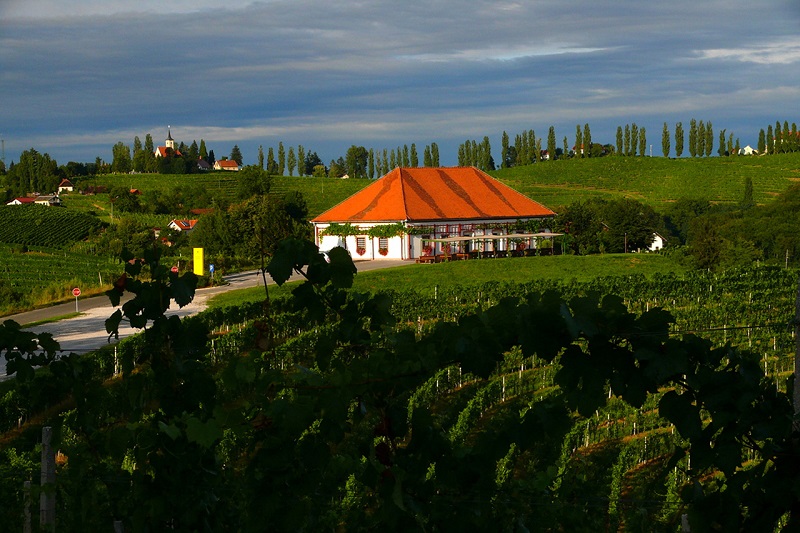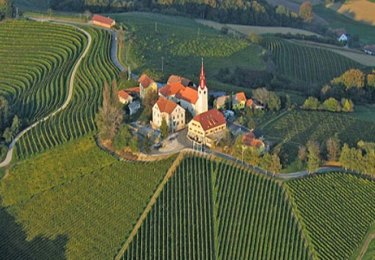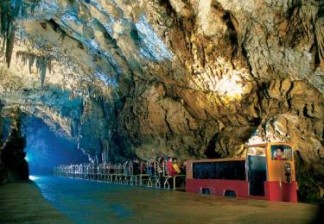
 Departure May – September
Departure May – September
Slovenia is one of Europe’s best kept secrets! You will be in awe of its world famous Bled Castle. Discover Bohinj, one of the most beautiful places in the heart of the Julian Alps. See the nation’s highest peak, Mount Triglav that lies in the middle of Triglav National Park. Besides the Alps, Slovenia is known for its caves – Postojna Cave and the UNESCO-listed Škocjan Caves. Visit the hills around Slovenia’s second-largest town, Maribor, renowned for their wine-making. Enjoy a traditional evening of food, alpine music and dance. Discover Slovenia is a trip into a land of enchantment!
Day 1: Ljubljana – Bled
Welcome to Slovenia and transfer to Bled. Overnight at the Grand Hotel Toplice
Bled: The image of Bled with the castle, the lake and the island in the middle of the lake, are sights by which Bled is known to nearly the entire world. The Bled Castle, stands watch over the town. Lake Bled is renowned for its exceptional beauty. In the middle of the lake lies the island with the Church of the Assumption. Inside the church there is the wishing bell from 1534. In addition to all these features, Bled and its surroundings provide a number of other interesting sights that are worth a visit.
Day 2: Bled – Bohinj – Bled
On this day visit the Castle of Bled, the oldest in Slovenia and located on a cliff from where you can enjoy an scenic view of the Slovene Alps and Triglav, the highest mountain and symbol of Slovenia. Later you may take a trip on boat to the island on Lake Bled to visit the church. After that you visit Vintgar Gorge located in Triglav National Park. For the afternoon we visit Lake Bohinj, the biggest in Slovenia and one of the most beautiful glacial lakes in Europe. Here you can also visit Savica waterfall, it is also possible to take the funicular to go to the top of Vogel Mountain where you can enjoy a wonderful view over the mountains. Return to Bled. Overnight in Bled
The 1.6 km long Vintgar Gorge carves its way through the vertical rocks of the Hom and Bort hills and is graced by the Radovna with its waterfalls, pools and rapids. The path leads you over bridges and Šumer’s galleries, and ends with a bridge overlooking the mighty 16 m high Šum waterfall. Due to its natural beauty, Vintgar was classified among the more important tourist sites in Slovenia and the number of visitors increases every year. From the Šum waterfall you can take the opportunity of walking up a picturesque footpath through Hom to St. Catherine-a historical church with a beautiful view. At the entrance, and at the Šum waterfall there are cafes serving refreshments.
Bohinj is one of the most beautiful places in the heart of the Julian Alps and in Triglav National Park. The natural beauty of high mountains, green forests, and beautiful mountain pastures and meadows, the cultural and historical monuments, and the friendly villages and towns with their hotels, restaurants, inns, and private rooms guarantee visitors a pleasant stay in Bohinj.
Day 3: Bled –Radovljica – Kropa – Mojstrana –Bled
Today discover secret and nice places: in Radovljica, near Bled, there is the interesting Museum of Apiculture. You continue to Kropa, which is a blacksmith town and where you can enjoy the works of the region. Nearby, there is a nice church of the Virgin Mary of Brezje, one of Slovenia’s main pilgrimage centers. In Vrba, near Radovljica, you may visit the house of the great Slovene poet France Preseren. In Begunje, in the area, there is an interesting castle and museum – grad Kamen, former prison during the 2nd WW. Enjoy walks in Mojstrana and from there to Vrata Valley where there is the waterfall: Slap Pericnik. Overnight in Bled
The Museum of Apiculture displays the rich tradition of Slovenian apiculture or beekeeping which was an important branch of agriculture in the 18th and 19th centuries. The art exhibition features a unique Slovenian folk art, painted beehive front boards. A copy of the apiary of the famous beekeeper Anton Jansa (1734-73) has been installed in nearby Breznica.
Day 4: Bled – Kranjska gora – Kobarid – Slovene Coast
For this day we suggest to go to Kranjska Gora for the first coffee of the day, after that take the scenic and highest mountain passage of Slovenia: Vrsic. Then go down through the panoramic Soca Valley, where you can visit the Julian Botanical Garden or the Museum of Trenta, to your choice. For the afternoon visit of the Kobarid Musem and departure to Slovene coast. Overnight at the Hotel Piran (Piran)
Kobarid gained world recognition thanks to the greatest highland battle in human history that took place during World War I. The vicinity of Kobarid is dotted by telling traces of trenches and fortifications and an imposing tomb on the St. Antony’s Hill, commemorating the Italian war casualties, reminding us of the ravages of war.
Day 5: Slovene Coast – Hrastovlje – Hum – Groznjan – Slovene Coast
This day will be devoted to explore the interior of the Slovene and Croat Istria. We will visit the famous murals of the “Dance of the Death” in Hrastovlje at the Church of the Trinity from the 12th C., after that we will go to Croatia to visit the “smallest town in the world” Hum, where we suggest to stop for lunch. We’ll continue to the charming medieval towns of Motovun and Groznjan. Return to Slovene coast. For the evening walk through the old center of Piran. Overnight in Piran
Hrastovlje In this little town there is a 12th century Trinity church adorned with many frescoes. Besides the dance of death, you can admire there several biblical scenes. The dance of death, discovered in 1950 and then properly restored, was painted by Jean de Kastav in 1490. It is different from other dances of death by the way its characters walk: they go from right to left, which is pretty unusual. Furthermore, the skeletons do not really dance; they walk in procession towards a skeleton sitting on a Gothic chair, who takes the place of the usual narrator. The skeleton raises with his right hand the lid of a coffin; a shovel and a hoe lie at his feet.
Koper is the main Slovenian port and the entrance to the inland of the Central Europe. It is located on the “top” of Istria. Koper was an island till the 19th century. Later the town and the island were connected with the mainland. Old town centre boasts with the rich architecture and cultural monuments.
Piran: It is a picturesque and lovely town that has preserved the medieval layout with narrow streets and compact houses, which rise in steps from the coastal lowland into the hills and give the whole area a typical Mediterranean look. The old seaport of Piran lies at the end of the Piran peninsula, which gradually narrows between the bays of Strunjan and Piran. The peninsula reaches Cape Madona, ending with the Šavrini hills. The meaning of the name Piran: elder scientists support the supposition that the origin could derive from the Celtic word bior-dun, supposed to mean a settlement on the hill, while younger generation advocates the explanation of the Greek word pyr, fire, as the original settlement was primarily used as a lighthouse for vessels sailing to nearby Greek colony Aegida on the site of today town Koper.
Day 6: Slovene Coast – Rovinj – Pula – Brioni – Slovene Coast
In this day we will discover old cities in the Croat cost. The beautiful Rovinj with its antique spirit, and Pula and its interesting Coliseum. Nearby the Brioni Islands’National Park is located, here is the place where the legendary General Tito, leader of the former Yugoslavia, had one of his favorite houses. We suggest also to stop in Porec to visit the famous Eufrasian Church to see its beautiful bizantine tiles. Return to Slovene coast. Overnight in Piran
Rovinj: It is beautiful to experience the old part of town, rich with numerous Romanesque -Gothic, Renaissance, baroque, neoclassical windows, balconies, altanas (terraces on the roofs), portals, stairs. Walking through narrow lanes and squares we will be fascinated with the beauty of tightly squeezed houses that hold each other up on the slope underneath the church of St Euphemia. Once, they were protected by the early medieval and renaissance town walls, partly preserved till today on the north and south sides of the Old Town.
Pula: Situated at the southest end of the Istrian peninsula has been in existence since 3 thousand years. It represents a very fine combination of the old and modern city where many famous writers and composers have found inspiration for their masterpieces. Many cultural and historical monuments dominate its panorama and represents today the unique setting of various cultural and artistic events. Facilities are located outside the town in woods close to the sea. Beaches stretch along, 100 km of beautiful and indented coast.
The Brijuni group of islands consists of Veli (Big) Brijuni, Mali (Little) Brijuni, Vanga (outside island), Jerolim, Kozada (Kotez, Kosada), Gaz (Gaza), Vrsar (Medvjedica), Galija, Madona (Pusti) Okrugljak (Obljak), Grunj (Grujevac), Supin (Supin veli, Veliki zupin), Supinic (Supin mali, Mali zupin) and St. Marko. The total area is 730 hectares, total coast line is 46.6 km., with 274 km of roads, paths and walks. The Brijuni islands stretch along the south-west coast of the Istrian peninsula, and are only 10 km from Pula. They are separated from the mainland by Fazana Channel which is on average 3 km wide. Having a mild Mediterranean climate, lots of sun and warm weather, and a rich vegetation, the islands guarantee an extremely pleasant stay.
Day 7: Slovene Coast – Postojna or Škocjan Caves – Idrija
After breakfast depart to Postojna to visit the marvelous underground Postojna caves or UNESCO Škocjan caves. We will also visit visit the Idrija mercury mine (UNESCO). Overnight at Kenda Manor
Because of their extraordinary significance for the world’s natural heritage, in 1986 the Skocjanske jame were included in UNESCO’s World Heritage List. Have an extremely complex system of cave passages in a total length of 5.8 km. The caves, with an immense underground gorge and halls, are the beginning of the Skocjan underground system. The height of the gorge exceeds 100 meters at several points. The caves probably have the biggest cave hall in Europe. The Reka river runs underground for almost 40 kilometres, to the sources of the Timav in the Gulf of Trieste.
The mysterious Postojna Cave world is the part of Slovenia which has been carved, shaped and created by water; deep within these world- famous caves hide the most precious beauty created through millions of years, drop after drop, year after year. The cave is accessible without special equipment, and has a constant temperature of 10 degrees Celsius. Visitors are taken for a tour by a special cave train.
Idrija mercury mine ore deposit is unique. Quoting Russian scientist Vladimir Ivanovich Smirnov: I have seen many ore deposits in different parts of the world and some of them quite complex. But I openly admit that such a complex geological structure as in Idrija, I haven’t yet seen. Without any doubt this is structurally one of the most complex endogenous ore deposits in the world. Mine Museum has rich geological collection with more than 800 different samples of ore and mineral from Idrija mercury ore deposit on display in Idrija Municipal Museum. While mine is now closed there are still some shafts which are maintained and turned into tourist museum shafts. Highlight is Anthony’s Main Road, the oldest part of the mine, today one of the oldest preserved mine entrances in Europe.
Day 8: Idrija – Ljubljana
Day fully dedicated to Ljubljana. After breakfast we will make a guided visit of the old- town center; we’ll admire the square of the greatest Slovene poet France Preseren, typical architecture of the secession style, Franciscan’s church, old food-market place, cathedral, Dragon’s bridge and the castle of Ljubljana with funicular railway. Free time for shopping and discovering the capital of Slovenia. We suggest visiting traditional Slovene evening with dinner. Overnight at the Grand Hotel Union
Ljubljana is the political and cultural heart of the Slovene nation. Its geographical position in the centereof Europe has determined Ljubljana as a natural meeting place for merchants and soldiers as well as – and more than once – peacemakers. It has been inhabited for some 5,000 years: first by Illyrians and Celts; then by Romans; and since the 7th century, by the Slavs. As its inhabitants and numerous visitors will tell you, Ljubljana is, indeed, a people-friendly city. Categorized as a medium-sized European city, it offers everything a metropolis does yet preserves its small-town friendliness.
A TRADITIONAL SLOVENE NIGHT
Experience traditional Slovenian hospitality and enjoy a hearty meal, delicious Slovenian wine, and an entertaining evening of music and dancing.
While dining on the specialities of traditional cuisine sit back and be entertained by enjoyable program featuring dancing, singing and folk music. The music and dancing makes it hard for anyone to sit still, but don’t worry, you will be able to join the dancers, learn the famous polka dance, or participate in the amusing games.
Day 9: Ljubljana – Kamnik – Logarska Valley
After the breakfast departure for medieval town Kamnik where will take a walk along streets to admire its beautiful heritage. We will continue to Budnar’s homestead near Kamnik with it`s house-museum; a real smoke kitchen where the guests will be able to make their own bread and eat it with traditional home meal. Afterwards continue to gorgeous Logarska Valley to admire a scenic alpine valley surrounded by high peaks. We will enjoy few hours in this beautiful nature. We recommended lunch with very tasting traditional local food. Overnight at the Hotel Plesnik
The medieval town Kamnik, is clearly a place of interest. You can walk its alleys and get to know its cultural herritage. Stop at the Franciscan monastery and the Church of St. Jacob, where the Chapel of God’s Grave and the Franciscan library, built by the plans of the architect Jože Plečnik, are especially fascinating. Accordnig to most visitors, the prettiest street in the town is Šutna. From the memorial tablets you can see, how many renowned people lived here. Today it is closed for traffic, so you can stroll throgh it and admire the buildings; the secessional building with the drugstore; the birhthouse of Rudolf Maister, the Church of Mary Immaculate, the first private museum in Slovenia, the Sadnikar’s Museum.
Where in the world you can bake bread in a smoke kitchen?
Budnar’s homestead is a place, where you get to know the past not by watching, but through experiencing! The Budnar’s homestead is a living museum.
Logarska Valley, one of the most beautiful glacial valleys in Europe, surprises its visitors with the peaks of the Kamniske-Savinjske Alps, the Rinka and other waterfalls, and many natural and cultural features that also enrich the neighbouring valleys of Robanov kot and Matkov kot. The valley is a starting point for mountaineering and alpine climbing routes and the valley itself offers bicycling, archery, riding, ski touring, cross-country skiing, sledding, and ice climbing on frozen waterfalls.
Day 10: Logarska Valley – Mežica – Maribor
After the breakfast we will continue our way to Mežica, where we will visit interesting mine and its museum. Along this route there are a lot of articles exhibited in the authentic environment, as if the miners had just left it. There is also a special tour through the mine with bikes possible. We will continue our way along the valley of river Drava to Maribor, where we will make walking city tour of Maribor, the second largest city in Slovenia, known for its ‘’oldest vine in the world’’ from the 15th C. that yearly produces around 60 liters of wine. In Maribor there are also many possibilities for wine tasting or visiting the Pohorje hill know for “Zlata lisica” ski world cup race for womens. Overnight at Hotel City in Maribor. http://cityhotel-mb.si/en/655/about-the-hotel.html
Guided cycling tour, more than 5 km long, along a path, illuminated by head- lamps warn on helmets, from one valley to another, where you can enjoy a safe, extraordinary and unforgettable adventure.
Maribor is the second largest city in Slovenia. Additionally, it is also the economic, university, cultural and sports centre of the north-eastern part of the country. The city offers for its visitors good wine and cuisine and has a well-preserved city core which reflects the images of centuries. The pulse of the city is reflected in the streets and squares. In the old city center, on the banks of the river Drava, the visitor to Maribor can see an amazing sight – the extraordinary ancient vine, called by the Mariborcani simply “stara trta”, 400 years old!!!- the Old Vine. Along the frontage of the long solid two-storey town house, facing the majestically flowing, serene Drava River. Planted in the center of the building, near the main entrance is the grapevine – the visitor will learn that the stalk is 81 cm in circumference in its widest part Pohorje is a mighty green hat of oxygen. It is crowned by three beautiful hills: Rogla (1517m) in the middle, Crni vrh (1543m) in the west and Velika Kopa. Pohorje is a paradise for walkers. A large number of marked ways, which are gathered on a map, enable the visit to the most natural sites in the beautiful and untouched nature.
Day 11: Maribor – Ptuj – Jeruzalem – Maribor
In the morning departure to Slovenske Gorice and Prlekija, the region that produces the best Slovenian wines; First stop will be Ptuj, considered as a town – museum to admire its castle and the historical centre. Afterwards we will proceed on the picturesque wine road of Jeruzalem, visit of a wine cellar and tasting of the delicious local wines. Return to Maribor and overnight. Overnight at the Hotel City
The heritage of past centuries will enchant even the most demanding visitor to Ptuj, the oldest city in Slovenia. Because of their historical significance, many buildings in Ptuj are protected as monuments. It is never boring in Ptuj, but it is particularly lively on festival days. The most characteristic costume of our region is the Kurent, a mythical creature who drives away the winter and cast spells for abundant crops in the fields of the surrounding villages.
The Biblical Jerusalem has its namesake in Slovenia. Jeruzalem – the viniferous hill has been famous for its high-quality wines since the middle Ages. The legend of the vine-covered Jeruzalem originates from the times of the crusades when the beauty of the hilly landscape and its wines enthralled the crusaders, sojourning on their way to the Holy Land by the castle near Velika Nedelja. They felt as though they had reached the Biblical Jerusalem and went no further. For that reason the highest hill, renowned for its distinguished wine, was named Jeruzalem. On the top of Jeruzalem stands a marvelous baroque church from the 16th century, holding the portrait of the Mourning Virgin, brought from the Holy Land.
Day 12: Maribor – Olimje – Kostanjevica – Otočec – Ljubljana
In the morning departure to Olimje and visit of its monastery with the oldest pharmacy in Europe, then proceed to Bizeljsko for a wine tasting of delicious champagne of the region. Continue in the direction to Ljubljana with visit of the Kostanjevica na Krki and its monastery. We will also make a stop for a coffee break in Otocec. Our last visit of this day will be interesting Sticna Monastery. Overnight at the Grand Hotel Union
Neighboring the Dolenjska winegrowing area, Bizeljsko-Sremic lies on the left (northern) bank of the Sava River. The soils here are a product of Miocene sediment decay mixed with materials eroded from neighbouring mountains. Rogaska Slatina is a famous spa in the area, with sources of thermal and mineral water, again a reminder of a lively geological past.
Modra Frankinja reaches its best in this area – the phenomenal 1983 vintage is archived in the Oresje Castle, which houses the area’s largest cellar. The best white wines are Sauvignon, Chardonnay, and Laski Rizling. The area grows a unique white vine, the autochthonous Rumeni Plavec, which ferments into an acid-rich wine used primarily for blending. This grape is grown in quantity only in the Bizeljsko-Sremic area and can not be found outside the Posavje region.
The area produces some characteristic blended wines: Bizeljcan is an aromatic, dry blend of Laski Rizling, Sauvignon, Rumeni Plavec, and Sipon; white Sremican is a dry blend of Laski Rizling, Sauvignon, and Rumeni Plavec; red Sremican is a dry red wine blended from Modra Frankinja, Zametna Crnina, and Laski Rizling – a somewhat rare combination since blending of red wines with white wines is quite uncommon in Slovenia.
Specialties of this area include white, rosé, and red sparkling wines produced in accordance with the Methode Champenoise and Tawny Port.
Kostanjevica na Krki, also Kostanjevica ob Krki ,is a small town and a municipality in the historic Lower Carniola region of southern Slovenia. It is today part of the Lower Sava statistical region. It is located in the northern foothills of the Gorjanci Hills near the border with Croatia, entirely on an island of the Krka River, and is also promoted as the “Venice of Lower Carniola” in Slovenian.
The town is protected as a cultural and historical monument.[4] Kostanjevica is the oldest city of the region. In the early 13th century, the Carinthian duke Bernhard von Spanheim established the Fons Sanctae Mariae Cistercian Abbey on the southern frontier of the March of Carniola, which he claimed against the resistance of the Patriarchs of Aquileia and the Dukes of Merania.
Otočec Castle, a jewel rising from the mists of the Krka River, is the only water castle in Slovenia and far around. Its earliest foundations were built in the Middle Ages, and its present appearance was created during the Renaissance when it became the property of Baron Ivan Lenkovič, the chief commander of the Croatia-Slavonia march. Otočec is the scene of two well-known stories by the Slovene author Ivan Tavčar, “Otok and Struga” and “Janez Sonce.”
Today the castle is a five-star hotel where rooms and apartments with period furniture unveil the centuries.
The monastery of Sticna is the oldest spiritual and cultural centre in Slovenia. It can be traced back to the year 1132, i.e. the Romanesque period. Also here, in Sticna, for the Slovene literature is very important, Sticna’s Manuscripts were written in 1428. They represent one of the first written monuments in Slovene language. Till today the oldest part, the core of the monastery has been preserved. White monks continue their centennial work in the Cistercian spirit condensed in their slogan Ora et labora.
Day 13: Depart Ljubljana
Free time and transfer to the airport. End of our services.
CALL NOW to BOOK 415-331-3791
NOTE: This tour requires 6 persons to guarantee departure.
Includes:
– Hotels per itinerary
– transfer with private bus and driver for whole tour
– guide for 14 days
– local guide in Croatia (mandatory)
– Breakfasts & Dinners only
– Traditional Slovene evening
– Entrance fees
Does not include:
– International or Domestic Airfare
– Carriage on Bled from 60 EUR per carriage (2-4 seats)
– Car parking where mandatory (10-15 EUR per day)
– Drinks at meals
– Lunch
– Tourist departure tax
– Gratuity
– Travel insurance
